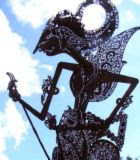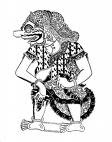
The Stories
Most shadow play is based on two epic stories from India. The Mahabarata and it's sister work, the Ramayana, elegantly depict eastern philosophies which have inspired many cultures. The Balinese and Javanese have combined the Hindu stories with Buddhist and Muslim ideas and their own folk lore. Usually, these stories are divided into many different episodes. Some episodes are purely Indonesian creations based on the epics.
Other stories from Indonesian history and myth are occasionally performed. Some favorites include Kala Rau - the eclipse of the moon, Calonarang - a call to witches, and Panji -Javanese folk tales.
The Dalang chooses a story appropriate to the village or venue sponsoring the performance. This choice is made to illustrate a useful moral. Upon arriving to perform, the Dalang asks about current local events and uses the story to illustrate solutions.
 The Dalang
The Dalang
The Dalang tells the story, manipulates all the figures, interprets characters and voices for each, and produces sound effects punctuating speech and movement. The Dalang also sings, cues the musical accompaniment, speaks several languages, and blesses the performance and surrounding area with mantras.
Dalang usually make most of the their own Wayang figures, eventually passing the craft to younger members of the family. Many Dalang are also wood carvers, painters, dancers, musicians, and priests. They are an integral part of Indonesian society and merit the highest respect of the people.
.

Characters and Language
Characters include kings, princes, teachers, giants, gods, demons, and citizens. Characters with narrow eyes are refined and elegant. Those with wide eyes are more down to earth.
Most characters speak in the language of Kawi - inspiration, or Jawa Kuno - ancient Javanese. Indonesian audiences generally do not know these languages well.
Translator servants impart details of the story in the vernacular language. They also inject their own insights and sense of humor.
 Music
Music
Shadow Play is accompanied by a Gamelan orchestra. Many styles of Gamelan instruments exist throughout Indonesia. Each area has a slightly different approach to accompaniment, though most share the same root traditions. Gamelan players respond to the spontaneous timing and direction of the Dalang. The repertoire typically consists of an overture, music for traveling, character pieces, and battle music.
Definition of Wayang Kulit
Wayang, in modern Indonesian language, is loosely translated to mean puppet. Kulit means skin or leather, the material from which the figures are carved. The Indonesian word for shadow, bayang, is clearly related and some would call it the origin of the word. But, Wayang is not always in shadow. In the old languages, the term Wayang reportedly originates from two earlier words: Waya = ancestors d escending, and Ang = a symbol.
escending, and Ang = a symbol.
Other types of Wayang plays include Wayang Lemah, similar to Wayang Kulit but taking place in daylight with no screen, Wayang Golek, three dimensional rod puppets, and Wayang Wong, dancers moving and relating as Wayang characters.
| Discover Indonesia/ Wayang Kulit | ||||||
The Dalang The Dalang The puppets are stored in line, in a banana tree trunk, behind the screen and in front of the puppeter. The puppeter is called the dalang.
| ||||||
-logo from SMAN1 kalidawir
-posting wayang by chuuandra
sma q paling oce.. .
memberi kecerdasan buat aku untuk sebuah blog.!! !




































